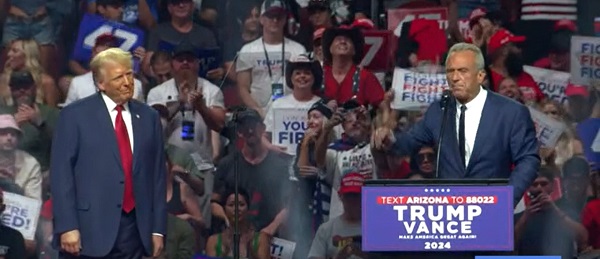Brownstone Institute
Congressional Committee Condemns (Nearly) Every Feature of the Covid Response

From the Brownstone Institute
By
The conclusion of the report: nothing worked and everything tried resulted in more damage than the pandemic could ever have achieved on its own. In this sense, and given the low bar of expectations for all such political commissions, every champion of truth, honesty, and freedom should celebrate this report.
Are there words in the English language that fully describe what happened during the Covid years that are not already overused? Calamity comes to mind. Disaster. Cataclysm. Ruin, devastation, catastrophe, unprecedented debacle, fiasco, and utter wreckage – all fine words and phrases but nothing quite captures it.
Given that, there is probably no report on the thing that can properly characterize the whole of it. On the other hand, it’s worth trying.
Meanwhile, the results of Covid commissions of governments around the world have become unbearably predictable. So far they have mostly said their government failed because they didn’t act fast enough, did not enforce lockdowns hard enough, did not communicate and coordinate well enough, and so on.
Everyone in the corporate world knows that when a committee reduces all problems to “communication and coordination” you are being fed a load of bull.
So far, it’s been almost entirely bureaucratic blather, and that helps account for the global loss of confidence in political systems. They cannot even be honest about the most catastrophic policies in our lifetimes or several.
The amount of corruption, waste, and destruction from this period of our lives, lasting from 2020 until 2023 but with remnants of bad policies all around us, is so unspeakable that not one report has yet been fully honest about what happened, why it happened, who really won and lost, and what this period implies for how vast swaths of the public see the world.
Among other astonishing revelations to come from this period was a full presentation of just how many institutions have been corrupted. It was not just governments and certainly not just the elected leaders and career bureaucrats. The problems are very deep and reach more deeply to intelligence agencies, military-based bioweapons systems, and preparedness agencies that guard their activities under the cloak of what is called classified.
This is a major reason why so many questions are being left unasked and unanswered. Then we have the ancillary failures in a whole series of additional sectors. The media went along with the nonsense as if they are wholly owned and controlled by government and industry. Industry mostly went along too, at least the highest reaches of it, even as small business was crushed.
The tech companies cooperated in a massive censorship operation. The retail end of the pharmaceutical companies enforced the government’s edicts, denying people basic medicines, as did the whole of the medical systems, which heavily enforced mandates on an experimental and failed product mistakenly called a vaccine. Academics were largely silent and public intellectuals fell in line. Most mainline religions cooperated in locking worshippers out. Banks were in on it too. And advertisers.
In fact, it’s hard to think of any institution in society that leaves this period untarnished. It’s probably not possible for a government report on the subject to be fully honest. Maybe it is too soon, plus the hooks that created the whole problem are still embedded too deeply.
All that said, we’ve got a solid start with the highest-level government report produced to date: After Action Review of the Covid-19 Pandemic: The Lessons Learned and a Path Forward, by the Select Subcommittee on the Coronavirus Pandemic as assembled by the US House of Representatives. The report was written by the majority and it shows.
Coming in at 550 pages with 2,000-plus footnotes (we have made a physical version available here), the preparation involved hearing from hundreds of witnesses, reading thousands of documents, listening to thousands of reports and interviews, and working at a furious pace for two years. Based on the outline and breadcrumbs of the Norfolk Group, while adding in additional material based on critiques of media and economic policy, it is a comprehensive blast against the public-health features of the pandemic response.
The conclusion of the report: nothing worked and everything tried resulted in more damage than the pandemic could ever have achieved on its own. In this sense, and given the low bar of expectations for all such political commissions, every champion of truth, honesty, and freedom should celebrate this report. It is an excellent breaking of the ice around the topic. Note that this report has received very little press attention, which only further underscores the problem.
Coming in for heavy criticism: gain-of-function research, the deference to the WHO, the lab-leak coverup, the funding of pharma cutouts, business and school closures, mask mandates, the lack of serious attention to disease monitoring, vaccine mandates, the sloppy approval process, the vaccine injury system, the banning of off-the-shelf therapeutics, social distancing, the rampant fraud in business loans, the effects of monetary policy, and more.
The report contains nuggets that we cannot help but praise:

Ignored in the report: the rental moratorium, the frenzy of Plexiglas and air filtration, the push for sanitizing all things, the reopening racket designed to prolong lockdowns, domestic capacity restrictions, the division of the workforce between essential and nonessential, the role of CISA and the intelligence agencies, the CDC’s push for mail-in ballots that might have been decisive in the national election, and the astonishing gibberish over the infection fatality and case fatality rates.
There is so much more to chronicle and criticize that the report could have been 10 or 100 times as long.
To be sure, the report has plenty of problems aside from these exclusions. Operation Warp Speed comes in for praise for saving “millions” of lives but the citation is to a modeling exercise that assumes what it is trying to prove. Look at the footnote: It’s bad science.
The real trouble with this section is not even its incorrect claim that the vaccine saved lives. The core issue is that the whole point of the lockdowns and all that followed was to create conditions for the release of the countermeasure. The plan from the beginning was: lockdown until vaccination. Praising the goal while criticizing the ineffective means diverts the point.
This is precisely what was explained to me in the early days in a phone call from a member of George W. Bush’s biosecurity team, a man who now runs a vaccine company. He said we would stay locked down until the world’s population got a shot in the arm. This phone call happened in April 2020.
Quite simply, I thought he had lost his mind and hung up. I did not believe that 1) the plan was always to stay in lockdowns until vaccination, and that 2) anyone seriously believed that governments could vaccinate their way out of a wave of respiratory infections insofar as the pathogen had a zoonotic reservoir.
The very idea struck me as so preposterous that I was incredulous that an educated and responsible adult could ever advance it. And yet that was precisely the plan all along. Sometime in the last week of February 2020, a global cabal decided to pull the trigger on a worldwide campaign of shock and awe – tapping every asset in civil society for assistance – to bring about worldwide forced medicalization with a new technology.
This was never really a public health response. That was only the cover story. This was a coup against science and against democracy, for purposes of industrial and political reset, not just in one nation but all nations at once. I get it: that is an ominous statement and hard to wrap one’s brain around the whole of it. In completely ignoring this point, the Select Subcommittee has missed the forest for the trees.
Let’s attempt a different metaphor. Let’s say your car is hijacked in Manhattan and you are thrown in the backseat. The goal is to drive all the way to Los Angeles for a drug deal. You could object to the means and goal but instead you spend the entire trip complaining about potholes, reckless driving, warning of the need for an oil change, and complaining about the bad music playing on the car radio.
At the end of the trip, you put out a report to this effect. Do you think that would be strange, to wholly ignore the theft of your car and the destination and purpose of the hijacking and instead focus on all the ways in which the grand larceny could have been smoother and happier for everyone involved?
In that spirit, the Subcommittee’s separate recommendations list is weak, leaving governments wholly in charge of anything labeled a pandemic while only suggesting a more cautionary approach that takes into consideration all costs and benefits. For example, it says on travel restrictions: “It is far easier to undo the restrictions that may have been unneeded than it is to take a ‘wait and see’ approach once the unknown virus of concern has entered our borders and thoroughly spread.”
It seems like the core lesson – governments cannot be masters of the microbial kingdom and allowing them to pretend otherwise for purposes of an industrial and political reset cues up a moral hazard that is an ongoing threat to freedom and rights – is not yet learned, or even so much as admitted. We are still being invited to believe that the same people and institutions who created calamity last time should be trusted again next time.
And keep in mind: this is the best report yet issued!
My friends, we have a very long way to go to absorb the fullness of the reality of what was done to individuals, families, communities, societies, and the whole world. Nor is it truly possible to move on without a full accounting of this disaster. Has it begun? Yes, but there is a very long way to go.
Brownstone Institute
The Unmasking of Vaccine Science

From the Brownstone Institute
By
I recently purchased Aaron Siri’s new book Vaccines, Amen. As I flipped though the pages, I noticed a section devoted to his now-famous deposition of Dr Stanley Plotkin, the “godfather” of vaccines.
I’d seen viral clips circulating on social media, but I had never taken the time to read the full transcript — until now.
Siri’s interrogation was methodical and unflinching…a masterclass in extracting uncomfortable truths.
A Legal Showdown
In January 2018, Dr Stanley Plotkin, a towering figure in immunology and co-developer of the rubella vaccine, was deposed under oath in Pennsylvania by attorney Aaron Siri.
The case stemmed from a custody dispute in Michigan, where divorced parents disagreed over whether their daughter should be vaccinated. Plotkin had agreed to testify in support of vaccination on behalf of the father.
What followed over the next nine hours, captured in a 400-page transcript, was extraordinary.
Plotkin’s testimony revealed ethical blind spots, scientific hubris, and a troubling indifference to vaccine safety data.
He mocked religious objectors, defended experiments on mentally disabled children, and dismissed glaring weaknesses in vaccine surveillance systems.
A System Built on Conflicts
From the outset, Plotkin admitted to a web of industry entanglements.
He confirmed receiving payments from Merck, Sanofi, GSK, Pfizer, and several biotech firms. These were not occasional consultancies but long-standing financial relationships with the very manufacturers of the vaccines he promoted.
Plotkin appeared taken aback when Siri questioned his financial windfall from royalties on products like RotaTeq, and expressed surprise at the “tone” of the deposition.
Siri pressed on: “You didn’t anticipate that your financial dealings with those companies would be relevant?”
Plotkin replied: “I guess, no, I did not perceive that that was relevant to my opinion as to whether a child should receive vaccines.”
The man entrusted with shaping national vaccine policy had a direct financial stake in its expansion, yet he brushed it aside as irrelevant.
Contempt for Religious Dissent
Siri questioned Plotkin on his past statements, including one in which he described vaccine critics as “religious zealots who believe that the will of God includes death and disease.”
Siri asked whether he stood by that statement. Plotkin replied emphatically, “I absolutely do.”
Plotkin was not interested in ethical pluralism or accommodating divergent moral frameworks. For him, public health was a war, and religious objectors were the enemy.
He also admitted to using human foetal cells in vaccine production — specifically WI-38, a cell line derived from an aborted foetus at three months’ gestation.
Siri asked if Plotkin had authored papers involving dozens of abortions for tissue collection. Plotkin shrugged: “I don’t remember the exact number…but quite a few.”
Plotkin regarded this as a scientific necessity, though for many people — including Catholics and Orthodox Jews — it remains a profound moral concern.
Rather than acknowledging such sensitivities, Plotkin dismissed them outright, rejecting the idea that faith-based values should influence public health policy.
That kind of absolutism, where scientific aims override moral boundaries, has since drawn criticism from ethicists and public health leaders alike.
As NIH director Jay Bhattacharya later observed during his 2025 Senate confirmation hearing, such absolutism erodes trust.
“In public health, we need to make sure the products of science are ethically acceptable to everybody,” he said. “Having alternatives that are not ethically conflicted with foetal cell lines is not just an ethical issue — it’s a public health issue.”
Safety Assumed, Not Proven
When the discussion turned to safety, Siri asked, “Are you aware of any study that compares vaccinated children to completely unvaccinated children?”
Plotkin replied that he was “not aware of well-controlled studies.”
Asked why no placebo-controlled trials had been conducted on routine childhood vaccines such as hepatitis B, Plotkin said such trials would be “ethically difficult.”
That rationale, Siri noted, creates a scientific blind spot. If trials are deemed too unethical to conduct, then gold-standard safety data — the kind required for other pharmaceuticals — simply do not exist for the full childhood vaccine schedule.
Siri pointed to one example: Merck’s hepatitis B vaccine, administered to newborns. The company had only monitored participants for adverse events for five days after injection.
Plotkin didn’t dispute it. “Five days is certainly short for follow-up,” he admitted, but claimed that “most serious events” would occur within that time frame.
Siri challenged the idea that such a narrow window could capture meaningful safety data — especially when autoimmune or neurodevelopmental effects could take weeks or months to emerge.
Siri pushed on. He asked Plotkin if the DTaP and Tdap vaccines — for diphtheria, tetanus and pertussis — could cause autism.
“I feel confident they do not,” Plotkin replied.
But when shown the Institute of Medicine’s 2011 report, which found the evidence “inadequate to accept or reject” a causal link between DTaP and autism, Plotkin countered, “Yes, but the point is that there were no studies showing that it does cause autism.”
In that moment, Plotkin embraced a fallacy: treating the absence of evidence as evidence of absence.
“You’re making assumptions, Dr Plotkin,” Siri challenged. “It would be a bit premature to make the unequivocal, sweeping statement that vaccines do not cause autism, correct?”
Plotkin relented. “As a scientist, I would say that I do not have evidence one way or the other.”
The MMR
The deposition also exposed the fragile foundations of the measles, mumps, and rubella (MMR) vaccine.
When Siri asked for evidence of randomised, placebo-controlled trials conducted before MMR’s licensing, Plotkin pushed back: “To say that it hasn’t been tested is absolute nonsense,” he said, claiming it had been studied “extensively.”
Pressed to cite a specific trial, Plotkin couldn’t name one. Instead, he gestured to his own 1,800-page textbook: “You can find them in this book, if you wish.”
Siri replied that he wanted an actual peer-reviewed study, not a reference to Plotkin’s own book. “So you’re not willing to provide them?” he asked. “You want us to just take your word for it?”
Plotkin became visibly frustrated.
Eventually, he conceded there wasn’t a single randomised, placebo-controlled trial. “I don’t remember there being a control group for the studies, I’m recalling,” he said.
The exchange foreshadowed a broader shift in public discourse, highlighting long-standing concerns that some combination vaccines were effectively grandfathered into the schedule without adequate safety testing.
In September this year, President Trump called for the MMR vaccine to be broken up into three separate injections.
The proposal echoed a view that Andrew Wakefield had voiced decades earlier — namely, that combining all three viruses into a single shot might pose greater risk than spacing them out.
Wakefield was vilified and struck from the medical register. But now, that same question — once branded as dangerous misinformation — is set to be re-examined by the CDC’s new vaccine advisory committee, chaired by Martin Kulldorff.
The Aluminium Adjuvant Blind Spot
Siri next turned to aluminium adjuvants — the immune-activating agents used in many childhood vaccines.
When asked whether studies had compared animals injected with aluminium to those given saline, Plotkin conceded that research on their safety was limited.
Siri pressed further, asking if aluminium injected into the body could travel to the brain. Plotkin replied, “I have not seen such studies, no, or not read such studies.”
When presented with a series of papers showing that aluminium can migrate to the brain, Plotkin admitted he had not studied the issue himself, acknowledging that there were experiments “suggesting that that is possible.”
Asked whether aluminium might disrupt neurological development in children, Plotkin stated, “I’m not aware that there is evidence that aluminum disrupts the developmental processes in susceptible children.”
Taken together, these exchanges revealed a striking gap in the evidence base.
Compounds such as aluminium hydroxide and aluminium phosphate have been injected into babies for decades, yet no rigorous studies have ever evaluated their neurotoxicity against an inert placebo.
This issue returned to the spotlight in September 2025, when President Trump pledged to remove aluminium from vaccines, and world-leading researcher Dr Christopher Exley renewed calls for its complete reassessment.
A Broken Safety Net
Siri then turned to the reliability of the Vaccine Adverse Event Reporting System (VAERS) — the primary mechanism for collecting reports of vaccine-related injuries in the United States.
Did Plotkin believe most adverse events were captured in this database?
“I think…probably most are reported,” he replied.
But Siri showed him a government-commissioned study by Harvard Pilgrim, which found that fewer than 1% of vaccine adverse events are reported to VAERS.
“Yes,” Plotkin said, backtracking. “I don’t really put much faith into the VAERS system…”
Yet this is the same database officials routinely cite to claim that “vaccines are safe.”
Ironically, Plotkin himself recently co-authored a provocative editorial in the New England Journal of Medicine, conceding that vaccine safety monitoring remains grossly “inadequate.”
Experimenting on the Vulnerable
Perhaps the most chilling part of the deposition concerned Plotkin’s history of human experimentation.
“Have you ever used orphans to study an experimental vaccine?” Siri asked.
“Yes,” Plotkin replied.
“Have you ever used the mentally handicapped to study an experimental vaccine?” Siri asked.
“I don’t recollect…I wouldn’t deny that I may have done so,” Plotkin replied.
Siri cited a study conducted by Plotkin in which he had administered experimental rubella vaccines to institutionalised children who were “mentally retarded.”
Plotkin stated flippantly, “Okay well, in that case…that’s what I did.”
There was no apology, no sign of ethical reflection — just matter-of-fact acceptance.
Siri wasn’t done.
He asked if Plotkin had argued that it was better to test on those “who are human in form but not in social potential” rather than on healthy children.
Plotkin admitted to writing it.
Siri established that Plotkin had also conducted vaccine research on the babies of imprisoned mothers, and on colonised African populations.
Plotkin appeared to suggest that the scientific value of such studies outweighed the ethical lapses—an attitude that many would interpret as the classic ‘ends justify the means’ rationale.
But that logic fails the most basic test of informed consent. Siri asked whether consent had been obtained in these cases.
“I don’t remember…but I assume it was,” Plotkin said.
Assume?
This was post-Nuremberg research. And the leading vaccine developer in America couldn’t say for sure whether he had properly informed the people he experimented on.
In any other field of medicine, such lapses would be disqualifying.
A Casual Dismissal of Parental Rights
Plotkin’s indifference to experimenting on disabled children didn’t stop there.
Siri asked whether someone who declined a vaccine due to concerns about missing safety data should be labelled “anti-vax.”
Plotkin replied, “If they refused to be vaccinated themselves or refused to have their children vaccinated, I would call them an anti-vaccination person, yes.”
Plotkin was less concerned about adults making that choice for themselves, but he had no tolerance for parents making those choices for their own children.
“The situation for children is quite different,” said Plotkin, “because one is making a decision for somebody else and also making a decision that has important implications for public health.”
In Plotkin’s view, the state held greater authority than parents over a child’s medical decisions — even when the science was uncertain.
The Enabling of Figures Like Plotkin
The Plotkin deposition stands as a case study in how conflicts of interest, ideology, and deference to authority have corroded the scientific foundations of public health.
Plotkin is no fringe figure. He is celebrated, honoured, and revered. Yet he promotes vaccines that have never undergone true placebo-controlled testing, shrugs off the failures of post-market surveillance, and admits to experimenting on vulnerable populations.
This is not conjecture or conspiracy — it is sworn testimony from the man who helped build the modern vaccine program.
Now, as Health Secretary Robert F. Kennedy, Jr. reopens long-dismissed questions about aluminium adjuvants and the absence of long-term safety studies, Plotkin’s once-untouchable legacy is beginning to fray.
Republished from the author’s Substack
Brownstone Institute
Bizarre Decisions about Nicotine Pouches Lead to the Wrong Products on Shelves

From the Brownstone Institute
A walk through a dozen convenience stores in Montgomery County, Pennsylvania, says a lot about how US nicotine policy actually works. Only about one in eight nicotine-pouch products for sale is legal. The rest are unauthorized—but they’re not all the same. Some are brightly branded, with uncertain ingredients, not approved by any Western regulator, and clearly aimed at impulse buyers. Others—like Sweden’s NOAT—are the opposite: muted, well-made, adult-oriented, and already approved for sale in Europe.
Yet in the United States, NOAT has been told to stop selling. In September 2025, the Food and Drug Administration (FDA) issued the company a warning letter for offering nicotine pouches without marketing authorization. That might make sense if the products were dangerous, but they appear to be among the safest on the market: mild flavors, low nicotine levels, and recyclable paper packaging. In Europe, regulators consider them acceptable. In America, they’re banned. The decision looks, at best, strange—and possibly arbitrary.
What the Market Shows
My October 2025 audit was straightforward. I visited twelve stores and recorded every distinct pouch product visible for sale at the counter. If the item matched one of the twenty ZYN products that the FDA authorized in January, it was counted as legal. Everything else was counted as illegal.
Two of the stores told me they had recently received FDA letters and had already removed most illegal stock. The other ten stores were still dominated by unauthorized products—more than 93 percent of what was on display. Across all twelve locations, about 12 percent of products were legal ZYN, and about 88 percent were not.
The illegal share wasn’t uniform. Many of the unauthorized products were clearly high-nicotine imports with flashy names like Loop, Velo, and Zimo. These products may be fine, but some are probably high in contaminants, and a few often with very high nicotine levels. Others were subdued, plainly meant for adult users. NOAT was a good example of that second group: simple packaging, oat-based filler, restrained flavoring, and branding that makes no effort to look “cool.” It’s the kind of product any regulator serious about harm reduction would welcome.
Enforcement Works
To the FDA’s credit, enforcement does make a difference. The two stores that received official letters quickly pulled their illegal stock. That mirrors the agency’s broader efforts this year: new import alerts to detain unauthorized tobacco products at the border (see also Import Alert 98-06), and hundreds of warning letters to retailers, importers, and distributors.
But effective enforcement can’t solve a supply problem. The list of legal nicotine-pouch products is still extremely short—only a narrow range of ZYN items. Adults who want more variety, or stores that want to meet that demand, inevitably turn to gray-market suppliers. The more limited the legal catalog, the more the illegal market thrives.
Why the NOAT Decision Appears Bizarre
The FDA’s own actions make the situation hard to explain. In January 2025, it authorized twenty ZYN products after finding that they contained far fewer harmful chemicals than cigarettes and could help adult smokers switch. That was progress. But nine months later, the FDA has approved nothing else—while sending a warning letter to NOAT, arguably the least youth-oriented pouch line in the world.
The outcome is bad for legal sellers and public health. ZYN is legal; a handful of clearly risky, high-nicotine imports continue to circulate; and a mild, adult-market brand that meets European safety and labeling rules is banned. Officially, NOAT’s problem is procedural—it lacks a marketing order. But in practical terms, the FDA is punishing the very design choices it claims to value: simplicity, low appeal to minors, and clean ingredients.
This approach also ignores the differences in actual risk. Studies consistently show that nicotine pouches have far fewer toxins than cigarettes and far less variability than many vapes. The biggest pouch concerns are uneven nicotine levels and occasional traces of tobacco-specific nitrosamines, depending on manufacturing quality. The serious contamination issues—heavy metals and inconsistent dosage—belong mostly to disposable vapes, particularly the flood of unregulated imports from China. Treating all “unauthorized” products as equally bad blurs those distinctions and undermines proportional enforcement.
A Better Balance: Enforce Upstream, Widen the Legal Path
My small Montgomery County survey suggests a simple formula for improvement.
First, keep enforcement targeted and focused on suppliers, not just clerks. Warning letters clearly change behavior at the store level, but the biggest impact will come from auditing distributors and importers, and stopping bad shipments before they reach retail shelves.
Second, make compliance easy. A single-page list of authorized nicotine-pouch products—currently the twenty approved ZYN items—should be posted in every store and attached to distributor invoices. Point-of-sale systems can block barcodes for anything not on the list, and retailers could affirm, once a year, that they stock only approved items.
Third, widen the legal lane. The FDA launched a pilot program in September 2025 to speed review of new pouch applications. That program should spell out exactly what evidence is needed—chemical data, toxicology, nicotine release rates, and behavioral studies—and make timely decisions. If products like NOAT meet those standards, they should be authorized quickly. Legal competition among adult-oriented brands will crowd out the sketchy imports far faster than enforcement alone.
The Bottom Line
Enforcement matters, and the data show it works—where it happens. But the legal market is too narrow to protect consumers or encourage innovation. The current regime leaves a few ZYN products as lonely legal islands in a sea of gray-market pouches that range from sensible to reckless.
The FDA’s treatment of NOAT stands out as a case study in inconsistency: a quiet, adult-focused brand approved in Europe yet effectively banned in the US, while flashier and riskier options continue to slip through. That’s not a public-health victory; it’s a missed opportunity.
If the goal is to help adult smokers move to lower-risk products while keeping youth use low, the path forward is clear: enforce smartly, make compliance easy, and give good products a fair shot. Right now, we’re doing the first part well—but failing at the second and third. It’s time to fix that.
-

 Automotive20 hours ago
Automotive20 hours agoTrump Deals Biden’s EV Dreams A Death Blow
-

 Automotive19 hours ago
Automotive19 hours agoCanada’s EV Mandate Is Running On Empty
-

 Business10 hours ago
Business10 hours agoWhy Does Canada “Lead” the World in Funding Racist Indoctrination?
-

 Focal Points1 day ago
Focal Points1 day agoPharma Bombshell: President Trump Orders Complete Childhood Vaccine Schedule Review
-

 Energy2 days ago
Energy2 days agoSenate votes to reopen Alaska Coastal Plain to energy leasing
-

 Media9 hours ago
Media9 hours agoThey know they are lying, we know they are lying and they know we know but the lies continue
-

 Daily Caller2 days ago
Daily Caller2 days agoTrump Orders Review Of Why U.S. Childhood Vaccination Schedule Has More Shots Than Peer Countries
-

 Alberta1 day ago
Alberta1 day agoA Memorandum of Understanding that no Canadian can understand













